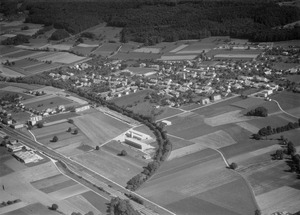Kappel, Switzerland facts for kids
Quick facts for kids
Kappel
|
||
|---|---|---|
|
||
| Country | Switzerland | |
| Canton | Solothurn | |
| District | Olten | |
| Area | ||
| • Total | 5.1 km2 (2.0 sq mi) | |
| Elevation | 425 m (1,394 ft) | |
| Population
(Dec 2020 )
|
||
| • Total | 3,278 | |
| • Density | 643/km2 (1,665/sq mi) | |
| Postal code |
4616
|
|
| Surrounded by | Boningen, Gunzgen, Hägendorf, Olten, Rickenbach, Wangen bei Olten | |
Kappel is a small town, also called a municipality, in Switzerland. It is located in the canton of Solothurn, within the Olten district.
Contents
History of Kappel
Kappel was first mentioned in official records way back in 1260! It was called Capella then. Later, in 1312, it was known as Nydern Capellen to tell it apart from another village called Oberkappelen (which is now Kestenholz).
What is Kappel's Geography Like?
Kappel covers an area of about 5.09 square kilometers (about 2 square miles). A big part of this land, nearly half, is covered by forests. About one-third of the land is used for farming. The rest of the area has buildings, roads, and a small amount of rivers.
The town of Kappel is found in the Dünnern valley, which is part of the Olten district. It sits to the north-west of a mountain called Born.
What Does Kappel's Coat of Arms Mean?
The coat of arms for Kappel is quite interesting! It shows a black chapel (a small church building) rising from a wavy base that is black and white. The background of the shield is gold. This design likely represents the town's name and its connection to water or a river.
Who Lives in Kappel? (Demographics)
Kappel has a population of around 3,000 people. A small part of the population, about 13%, are people from other countries who live there. Over the last ten years, the number of people living in Kappel has grown by about 14%.
Most people in Kappel speak German, which is about 93.5% of the population. A smaller number of people speak French or Albanian.
In 2008, the population was split evenly between men and women. About 25% of the people living in Kappel in 2000 were born there. Many others were born in the same canton (Solothurn) or elsewhere in Switzerland.
The age groups in Kappel in 2000 were:
- About 6.7% were children (0-6 years old).
- About 18% were teenagers (7-19 years old).
- About 32.4% were adults aged 25-44.
- About 25.5% were adults aged 45-64.
- About 12.4% were seniors (65 and older).
Most households in Kappel have about 2.5 people. About a quarter of the households are made up of just one person. Many families with children also live there.
The chart below shows how Kappel's population has grown over many years:

How Do People in Kappel Work? (Economy)
In 2010, the unemployment rate in Kappel was about 3.1%, which means most people had jobs.
Jobs in Kappel are divided into three main types:
- Primary sector: This includes jobs like farming. A small number of people work in this area.
- Secondary sector: This includes jobs in manufacturing (making things) and construction (building things). About 133 people worked in this sector in 2008.
- Tertiary sector: This is the largest sector and includes jobs in services. This means jobs like sales, transportation, hotels, restaurants, healthcare, and education. About 271 people worked in this sector in 2008.
Many people who live in Kappel travel to other towns for work. In 2000, about 1,163 people commuted out of Kappel for their jobs. Most people (about 63.8%) use a private car to get to work, while some (about 14.5%) use public transportation.
What Religions are Practiced in Kappel?
According to a census in 2000, the main religions in Kappel were:
- Roman Catholic: About 55% of the population.
- Swiss Reformed Church: About 22.6% of the population.
There were also smaller groups of people who belonged to other Christian churches, Islam, Buddhism, and Hinduism. About 11.8% of the population did not belong to any church.
How is Education in Kappel?
Education is important in Kappel. Many adults have completed high school, and about 11.5% have gone on to higher education, like university.
In the 2010-2011 school year, there were 244 students in Kappel's schools.
- Kindergarten: Children can attend two years of non-required Kindergarten. In 2010-2011, 59 children were in kindergarten.
- Primary School: Students attend six years of primary school. There were 185 students in primary school in Kappel.
- Secondary School: After primary school, students go to secondary school. All students from Kappel attend their lower secondary school in a nearby town.
In 2000, 204 students from Kappel went to schools outside the town.
See also
 In Spanish: Kappel para niños
In Spanish: Kappel para niños






